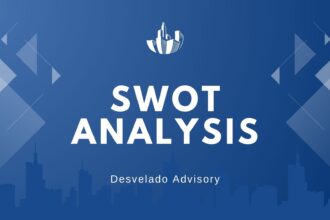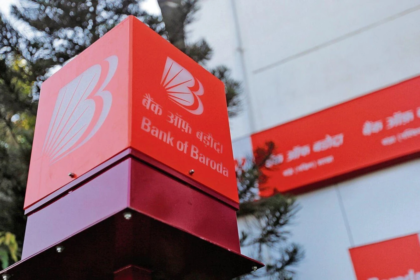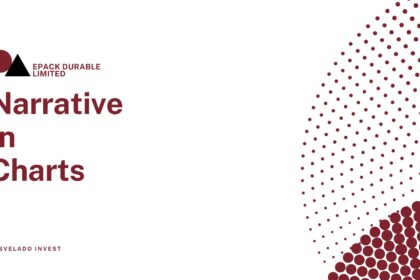NSE: BANKBARODA
Strengths
• Expanding Reach with a Focus on Rural and Priority Sectors; BoB boasts a vast network of 8,200+ branches and 11,000 ATMs in India, along with 100 branches across 17 countries, ensuring strong domestic and international reach. This expansive presence allows the bank to cater to diverse customer needs across urban and rural demographics, especially when the bank intends to increase its focus on underleveraged rural and priority sectors.
• Digital Milestones; BoB has heavily invested in digital transformation, with its “Bob World” platform serving over 30 million active customers. The bank ranks 3rd in UPI remittances, and 95% of its transactions are conducted digitally, including 93% of savings account acquisitions and 95% of current account acquisitions. These milestones reflect the bank’s ability to enhance customer experience, reduce costs, and drive revenue through digital cross-selling.
• Leveraging a Diversified Product Suite for Cross-Selling Opportunities; Through its subsidiaries, BoB provides a wide range of financial products, including life insurance, mutual funds, retail broking, investment banking, infrastructure financing, and rural debt solutions. This diversified product suite enables the bank to address various customer needs, creating cross-selling opportunities and improving wallet share. [1]
• Improving asset Quality; The bank has demonstrated substantial improvement in asset quality, with declining NPAs and a high Provision Coverage Ratio (PCR). This reflects strong underwriting practices, prudent risk management, and the use of technology for better credit assessment. As per management, The bank plans to leverage data analytics and expand into unsecured lending for sustained growth.
• Financial Stability with Brand Trust and Government Support; BoB is enjoying strong brand recognition and customer trust. Also, As a public sector bank, BoB benefits from government support and access to capital. However, BoB maintains a comfortable capital adequacy ratio, ensuring financial stability and capacity to support future growth. Its focus on profitability and internal accruals minimizes reliance on frequent capital market interventions.
Weaknesses
• High Dependence on Corporate Lending; Despite efforts to rebalance the portfolio, BoB still relies heavily on corporate lending, exposing it to cyclical volatility. This dependence could impact profitability during economic downturns. The bank is actively addressing this weakness by increasing the share of retail lending and aiming for a more balanced portfolio in the long term.
• Lagging Fee Income; Compared to private sector banks, BoB generates lower fee income as a percentage of total income. This limits revenue diversification and overall profitability. The bank is actively seeking to increase fee income through strategic initiatives in corporate banking, wealth management, and digital channels
• Elevated NPAs in MSME and Agriculture Segments; Despite improvements, certain segments like MSMEs (8.7% GNPA) and agriculture advances (5.3% GNPA) continue to show elevated levels of non-performing assets. The overall slippage ratio remains stable but requires monitoring to avoid future risks.
• Public sector entity, decision-making processes can be slower and more bureaucratic, hindering agility and responsiveness to market changes.
Challenges
• India’s Economic Growth; With India’s GDP projected to grow at 6.3% in FY24-25 (RBI forecast), key sectors such as infrastructure, renewable energy, and MSMEs are expected to see increased credit demand. The Indian banking sector is anticipated to grow at a CAGR of 9.6% between 2023 and 2028, creating a conducive environment for BoB to expand its lending and deposit base.
• Expanding MSME Segment; The MSME sector in India is a significant growth driver, offering substantial lending opportunities for BoB. The bank can leverage technology to develop innovative products and services tailored to the needs of MSMEs. BoB’s strong branch network and focus on financial inclusion provide a competitive advantage in serving this segment.
• Unlocking Growth Potential in Rural Markets and High-Potential Trade Corridors; Rural and semi-urban markets still account for about 65% of India’s population but contribute only 15% to the total credit portfolio. Targeted expansion in these regions can unlock significant growth potential. BoB’s international operations, contributing 16% of its global business as of FY24, can be further strengthened by focusing on high-potential trade corridors such as India-UAE and India-Southeast Asia.
• Strategic Alliances and Fintech Partnerships for Growth; Collaborations like Baroda BNP Paribas Asset Management have helped grow the asset under management (AUM) to over ₹22,000 crore as of FY24, demonstrating the success of strategic alliances. Partnerships with fintechs in areas like wealth management can enhance customer offerings and reduce acquisition costs. India’s fintech market is projected to reach $150 billion by 2025, presenting vast collaboration opportunities.
• Financial Inclusion and Digital Penetration for Cross-Selling Opportunities; Under PM Jan Dhan Yojana, over 500 million accounts have been opened, creating a vast base for cross-selling products like insurance, loans, and digital services. Increasing digital penetration (over 900 million internet users projected by 2025) can drive adoption of BoB’s mobile banking apps, digital payments, and online services.
• With India aiming to achieve net-zero carbon emissions by 2070, there is a growing demand for green financing. BoB can enhance its portfolio in renewable energy and sustainable projects, which already contribute 10% to its corporate credit portfolio. (BoB Earth)
Threats
• Mitigating Risks Amid Global Slowdown and Economic Uncertainty; A global economic slowdown, projected at 2.9% GDP growth for 2024 (World Bank), or a domestic slowdown could reduce credit demand and strain asset quality, especially in vulnerable sectors like MSMEs and agriculture. Rising inflation and geopolitical tensions may increase default risks in key lending portfolios.
• Regulatory Changes and Compliance Costs: such as increased provisioning norms or stricter asset classification guidelines by RBI, could impact profitability. Compliance with evolving global standards, including Basel III norms, may require higher capital allocation, potentially affecting growth investments.
• Cybersecurity to Safeguard Digital Banking Operations; The growing reliance on digital banking exposes BoB to cybersecurity threats, with India recording over 1.4 million cyber incidents in 2023 (CERT-In data). Sophisticated phishing and ransomware attacks can harm customer trust and lead to financial and reputational losses.
• Disruption by Fintech and New Technologies: India’s fintech sector, valued at $50 billion in 2023 and expected to reach $150 billion by 2025, is intensifying competition in payments, lending, and wealth management. Emerging technologies like blockchain and AI are transforming banking models, requiring BoB to rapidly innovate to remain competitive.
• Decline in Bank Deposit Growth: The Indian banking sector is witnessing declining deposit growth rates, falling to 9.5% YoY in FY24 from 11.8% in FY23 (RBI data). Slower deposit growth, particularly in low-cost CASA deposits, could lead to margin compression as the bank may need to rely more on higher-cost funding options. This may affect liquidity and constrain the bank’s ability to support credit growth, especially in key retail and MSME segments. Additionally, the increased competition from private banks and fintechs for deposit acquisition could necessitate offering higher deposit rates, potentially impacting profitability. To mitigate these risks, BoB will need to focus on enhancing digital deposit acquisition, strengthening its CASA base, and optimizing its funding mix to maintain margins and support its growth objectives.
• Threat from Entrants; The growing competition from small finance banks (SFBs), NBFCs, and mutual funds offering higher returns presents a significant challenge for BoB in acquiring and retaining deposits. As these institutions attract customers with more attractive interest rates and investment products, BoB could face difficulties in maintaining its CASA deposits and may have to rely more on higher-cost term deposits, which could compress its Net Interest Margins (NIMs). Additionally, the shift of retail funds to mutual funds, especially among younger customers seeking better returns, could erode BoB’s market share. To stay competitive, the bank might be forced to offer higher deposit rates, increasing its cost of funds and potentially impacting profitability. In response, BoB will need to focus on digital banking solutions, enhance its CASA base, and explore innovative deposit products to mitigate these challenges and maintain sustainable growth.
• Interest Rate Cycles: The current repo rate of 6.5% in FY24 presents challenges for BoB, primarily through potential margin compression and profitability pressures. Higher interest rates could increase the cost of funds, squeezing Net Interest Margins (NIMs) as the bank may not be able to immediately pass on the increased costs to borrowers. Additionally, the rise in borrowing costs could dampen loan demand, particularly in sectors like housing and personal loans, potentially slowing down credit growth. The increased cost of borrowing could also elevate the risk of defaults, putting pressure on asset quality. To mitigate these impacts, BoB will need to manage its asset-liability structure efficiently and focus on optimizing its loan portfolio while leveraging its digital capabilities to sustain profitability and growth in a higher interest rate environment.







